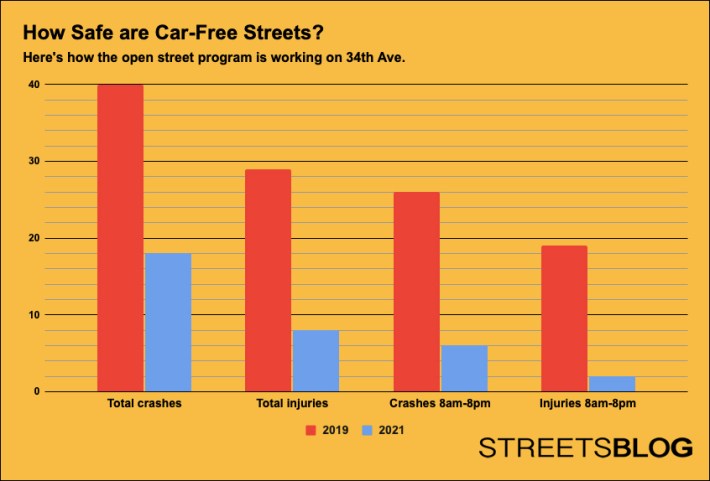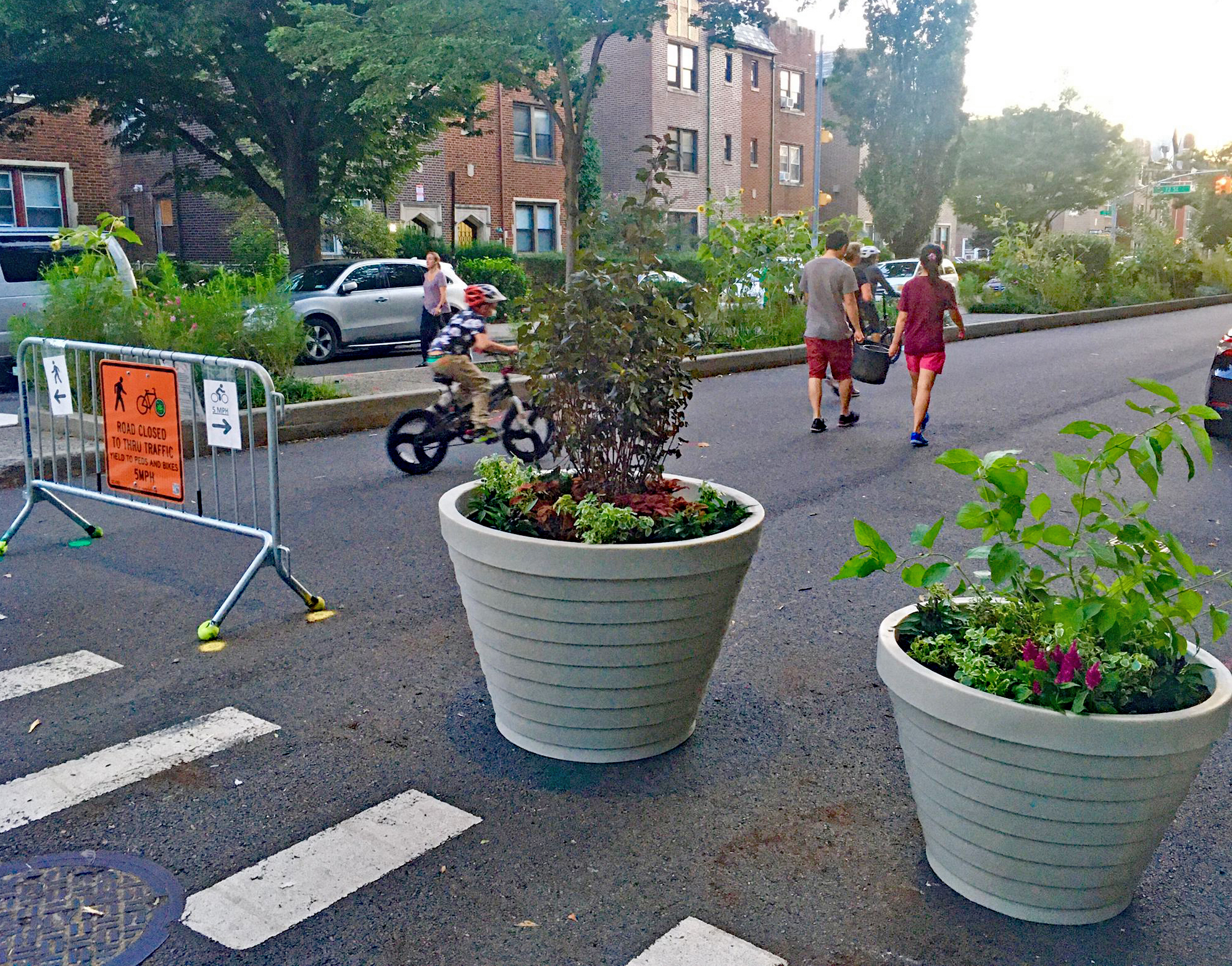When cars are banished from roadways, total crashes drop dramatically and injuries to pedestrians and cyclists almost entirely disappear, a new Streetsblog analysis shows.
It has long been known that the 34th Avenue open street — where barricades are deployed by throngs of volunteers to keep cars out between 7 a.m. and 8 p.m. — showed initial promise not only as a safe place for recreation during the Covid-19 pandemic, but also as an area with reduced car crashes, but a review of all crash data from the entirety of 2021 shows that the roadway is even safer than originally believed.

Comparing crashes from the last full pre-pandemic year (2019) to all of 2021 along 34th Avenue between 69th Street and Junction Boulevard, Streetsblog found:
- In 2019, there were 26 reported crashes in 2019 during what would have been the open street hours, but only six crashes during the same 12 hours in 2021, a drop of 77 percent.
- In 2019, 19 people were injured during what would have been the open street hours, but only two people were injured during the same hours in 2021, a drop of 89 percent.
- In 2019, seven pedestrians and cyclists were injured during the 8 a.m. to 8 p.m. hours, but only one pedestrian was injured during those same hours in 2021.
Streetsblog also found that crashes and injures dropped dramatically even outside the open street hours, most likely because fewer drivers use 34th Avenue, having become accustomed to the fact that it is off-limits to them half the day.
- There were 40 total reported crashes in 2019, By 2021, that dropped to 18, a decrease of 55 percent.
- Total injuries for the year dropped from 29 in 2019 to eight in 2021, a decrease of 72 percent.
Those numbers follow — and improve upon — the pattern seen in the earliest days of the pandemic, when injuries fell by 85 percent and crashes dropped by 78 percent during the hours when cars were banished from the roadway.
Open streets opponents have argued that safety on 34th Avenue has come at the expense of neighboring roadways, but journalist Steven Bodzin easily debunked that claim:
The safety on car-free streets is no surprise to people who advocate for them.
"If these are the safety results we’ve gotten from cheap barricades, imagine how safe a 24/7 linear park would be," said Luz Maria Mercado, who has been advocating for 34th Avenue to be turned into a real car-free park, not merely a place where drivers are discouraged.
She was quick to remind her neighbors that Mayor Adams had signed the linear park petition, as did the neighborhood's newly elected Council member, Shekar Krishnan.
"We look forward to working with them and our whole community to design a linear park that maximizes green space and prioritizes people over cars," Mercado added.
Transportation Alternatives pointed out wider implementation of truly car-free open streets would benefit more communities than merely Jackson Heights.
“We need to expand the open street program equitably citywide so that every neighborhood has access to safe open space," said Queens Organizer Laura Shepard, whose organization has studied the wider benefits of open streets. "Bringing permanent, 24/7 open streets to more places will help New York City meet its Vision Zero goals.”
In October, the Department of Transportation released a preliminary plan for the permanent open street that would create several car-free blocks, but mainly rely on diverters at all 26 intersections along the 1.3-mile east-west corridor to reduce, but not entirely prevent, thru traffic. Consisting of paint and a block of cement, the diverters are meant to prevent drivers from treating the roadway as the speedway it was before the implementation of the Covid-era open street program in May, 2020, but they allow drivers to turn onto the open street from cross streets, so it is unclear how effective they will be in keeping cars out.
A study last year showed that the key to safety and popularity of open streets is directly linked to keeping cars out.
And as a candidate last year, Mayor Adams promised to "pedestrianize more of the city [and] discourage car use with more open space and open markets, while improving public safety and making the city more livable for its residents." As such, the agency told Streetsblog that work on 34th Avenue would commence later this year.
“It should come as no surprise that by reclaiming space from cars we make our streets safer," said DOT spokesman Seth Stein. "We look forward to working hand-in-hand with the community to implement improvements to the 34th Avenue open street so it can serve the neighborhood for generations to come.”
Note: For most of the study period, open street hours were 8 a.m. to 8 p.m. Starting shortly after the start of the 2021-22 school year, open street hours began at 7 a.m. on 34th Avenue because of the presence of six schools.






